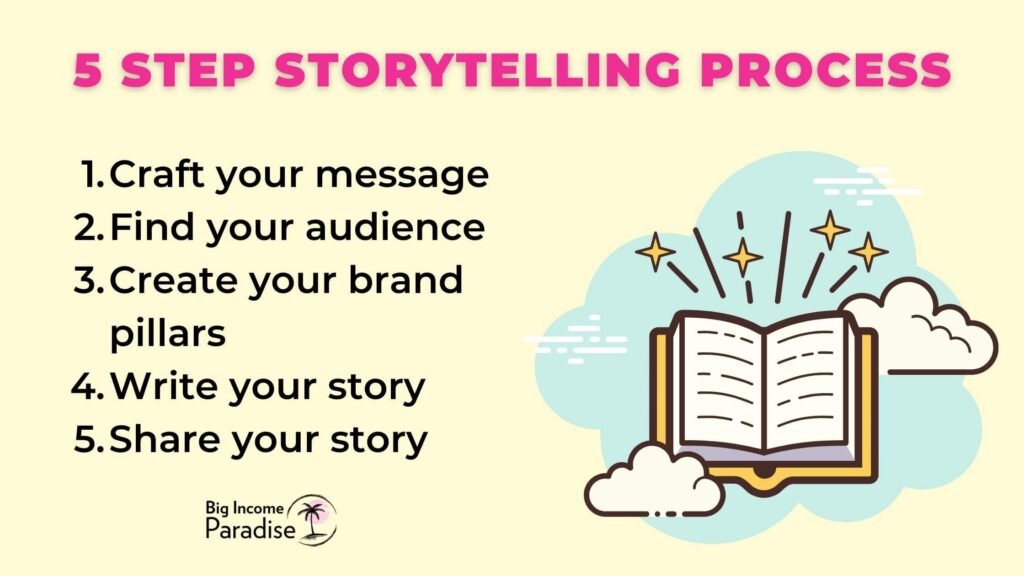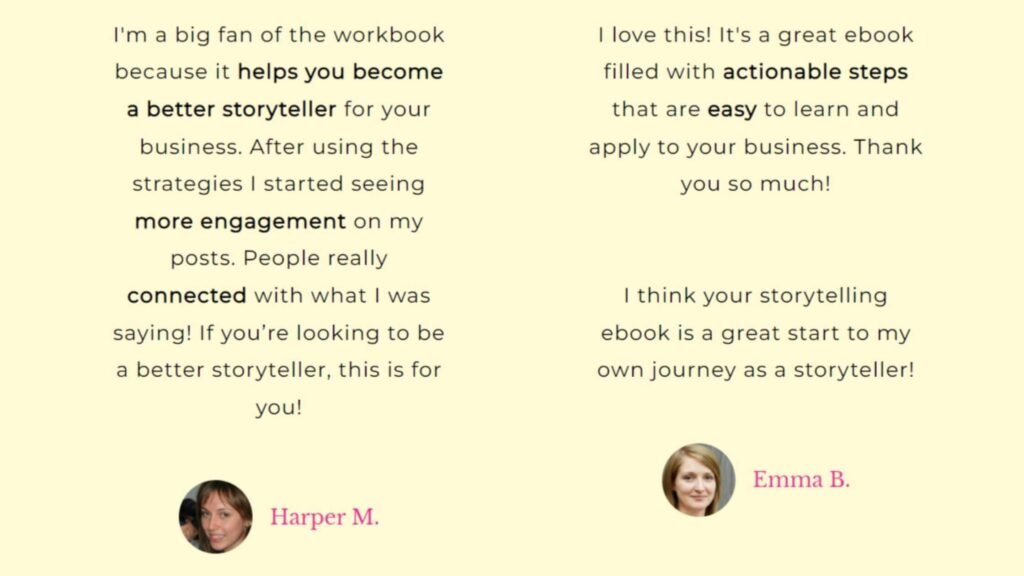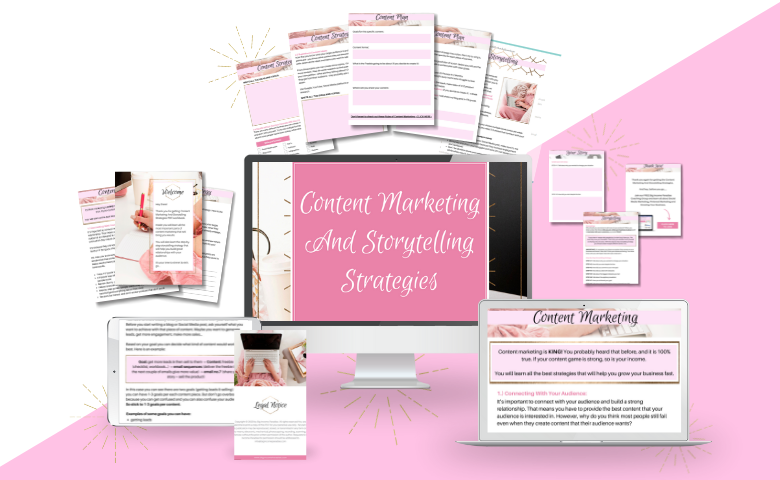If you have been trying to get the attention of your target audience and turn them into loyal customers, then you’re in the right place.
Business storytelling is one of the most powerful methods that you can use to grow your small business.
When done right, storytelling can help you build connections with your audience, increase brand awareness, and boost sales.
However, if you’re not sure how to get started with it, it might feel a bit overwhelming. This is why I’ve created the complete guide to show you how to create stories that will make your audience fall in love with your brand.
Now let’s look at the importance of storytelling in business and how it can help you.

This post includes affiliate links to products I love and recommend, meaning I may receive a small commission at no extra cost to you. I will use the earnings to maintain my blog and business so that I can deliver more value and knowledge to you.
5 C’s of Business Storytelling
What is storytelling in business?
Business storytelling is the art of telling your potential customers about your products or services in a relatable, intriguing story format rather than just stating facts and statistics.
It has become a popular marketing strategy in recent years because it uses the power of human emotion to sell.
Why is storytelling important in business?
Business storytelling is essential because it humanizes your brand and helps you connect with your audience on a more personal level, which builds trust.
This strategy has become an essential part of the business world because customers are starting to demand more from the brands they buy from.
It’s no longer enough to have great products and services; customers want to feel an emotional connection to brands before buying.
I’ve learned this the hard way. Unfortunately, I didn’t use storytelling for a while and my audience didn’t connect with me. All my marketing felt cold.
But all that changed when I started telling stories. It was scary at first because I felt vulnerable. However, that’s exactly what moves the needle.
People are being sold to every minute of every day. Ads and content creators share on social media, commercials on some streaming services, billboards as you drive down the highway, and even brochures in the mail.
It’s easy to get overwhelmed by the constant barrage of marketing because it’s everywhere you look, so it takes a unique approach to cut through the noise.
This is why storytelling is so powerful. When done right, stories create an essential connection, a sense of belonging, and a strong desire.
It’s different from what people see in the marketplace, so it stops their scroll. It makes them think and imagine what their life could be like if they invested in your product or service.
The emotional pull of a good story is what it takes to help a customer jump off the fence and jump onto the “buy” button. This is especially true for a small business owner trying to get recognized.

How can storytelling help your business?
Business storytelling can help your business grow faster because it will engage your audience, build an emotional connection with them, and ultimately get them to buy from you.
Storytelling is the new way to get your message out into the world. By telling a story and appealing to the emotions or needs of your potential customers, your brand becomes more personable and relatable. It’s these kinds of brands that are memorable.
Just think about your favorite companies or influencers. Why did you start following and buying from them? It was probably because they shared stories you could relate to and made you feel like part of their community.
A good story takes your marketing and makes it 3-D. It’s no longer just a course or e-book to invest in; it’s a lifestyle or goal they want to achieve.
You are selling them on what your digital business can do for them. Using storytelling to outline how your personal brand can do that – you will create loyal customers.
Crafting a powerful business story will help you stand out from your competition and become memorable to customers.
People connect easily with stories they feel can relate to or inspire them. That connection will help them engage with your brand because they want to know more.
How does business storytelling work?
There are plenty of ways to craft your business story, but whether you’re a digital marketer just starting out or a large business already successful, there is a specific way to create business storytelling that works.
Let’s break down a simple 5-step storytelling process that’ll help you connect with your customers more effectively. Here’s how you can do it:
- Craft your message: Think about what you want to share about your product or service. Ask yourself: What does it do? How can it make your audience’s life easier or better? Why should they care about it?
- Find Your Audience: Figure out who needs your product or who would be excited to have it. These are the people who will listen to what you’ve got to say!
- Create Your Brand Pillars: Once you know your message and who you’re talking to, decide on a few key ideas that showcase what’s cool and valuable about your brand. Think of these as the backbone of your story.
- Write Your Story: Now, take everything you’ve planned and turn it into an engaging story. Think about the feelings you want to spark in your audience. Do you want to inspire them? Make them feel understood? Choose your emotions wisely to make your story hit home.
- Share Your Story: Lastly, use your main story to guide all your marketing materials so everything feels connected. This way, every piece of content helps tell your story and makes your marketing stronger.

How to use storytelling in business?
First, you want to make sure you have a good story. You’re not alone if you’re overwhelmed about where to add it to your current strategy. I’ve been there too. But don’t worry, it’s not hard at all.
The simplest way to do it is to make business storytelling a significant part of your entire brand, and over time it will start to come naturally. Remember, practice will always make you a better storyteller.
Once you decide what story your brand is here to tell, it makes it easier to weave it into everything you do. It should inform your social media content strategy, the way you advertise your products or services, the new offerings you add, and the overall vibe of your business.
The key is to become crystal clear about what your story is meant to evoke from your audience. Do you want them to feel inspired, intrigued, or curious? Maybe all three?
Use storytelling to invite potential customers into your world by making them feel like they want an exclusive VIP ticket.
You can use this strategy every day by creating things like a nurturing email sequence or a social media post. Whenever a customer subscribes to your email list, they should receive this sequence of emails that takes them on the journey of how your product or service was created and what it can do for them. This will help them decide to buy.
This sequence will establish you in the customer’s mind because they will be getting several emails from you over days or weeks. It helps them connect with your brand and keeps them engaged because they are on the edge of their seat to keep learning more.
By the end of the sequence, your potential customer should be educated on:
- how your product or service came to be,
- what it can do for them,
- why it’s essential,
- and how to access it.
This method uses storytelling to form a relationship with customers and bring them into your world before they’ve even purchased from you.
This same strategy can be used with social media as well. If you run your brand mostly on social media sites like Instagram, you can create engaging posts, stories, and reels that educate your followers on these different areas of your business and draw them to you.
The most important thing to focus on is making sure you have a good story. Would you buy from you? If not, you may need to go back to the drawing board – after all, you’re in a storytelling business.
Different types of business storytelling
As you can imagine, business storytelling is not one-size-fits-all. While the concept remains the same, there are a few distinct types of storytelling for business.
Depending on the kind of business you have and your goals, you may use just one or a sample from all of them.
Here is a breakdown of some of the most popular types of storytelling:
Visual storytelling
Visual storytelling is a type that uses videos and imagery to convey the story to the customer. It can take many different forms:
- Whether you are using videos on YouTube or embedded into your website or emails,
- Or graphics on Instagram, Facebook, Pinterest, etc.
Because this type of storytelling is such a broad category that covers so much, there are countless ways to use it in your business.
These are some visual storytelling examples to help your business grow faster:
- Create short teaser videos for your website or social media feed.
- Use simple, bright graphics to showcase essential performance metrics.
- Show real photos of your customers using your product.
- Become a presence on social media with lives, stories, and reels.
- Start a vlog YouTube channel with vlog-style videos of your business life.
Short teaser videos
Creating video content doesn’t need to be intimidating. You can create high-quality videos with your smartphone and good lighting.
You can create short videos of your products or services that show customers what to expect or leave them wanting more. This business storytelling type will go further than just reading a product description on a page.
Simple, bright graphics
It’s easy to fall into making complicated graphics for your business. While you might think it makes you look more polished or professional, that is not the case. Use simple, easy-to-read graphics to show timelines, awards, customer journeys, etc.
At the beginning of 2024, when I was analyzing some successful business owners, I noticed they were going back to basics. Their visuals are simple and they’re using basic marketing strategies. So if it works great for them, it will work for you too.
The most important things to remember are:
- use bright, appealing colors that match your branding,
- a font that is easy to read,
- and minimize the clutter on the page whenever possible.
Doing these few things will allow your graphic to tell the story.
Do you find it challenging to create amazing graphics that would attract your target audience? Look no further – The 100 Viral Graphic Templates are here to save you!

Real photos
Original photos of your product in customers’ hands or on their computers – are more interesting than stock photos or highly styled photoshoots. While there is a time and a place for these pictures, it goes a long way to show authentic images.
You could also show how you’re creating a new product. Sharing behind-the-scenes is what will help your audience connect with you. They’re curious about what you’re up to.
Social media presence
Social media is where people spend most of their downtime during the day, so it’s essential to realize the importance of this channel.
There are plenty of features to help you engage with and attract customers (for example, polls), so use them. The more you show up on social media with informative or entertaining reels, funny stories, or beautiful feed posts, the more you will be optimized in the algorithm and shown to your ideal clients.
Start a vlog channel
Vlogs are a great way to help your audience see the real you in a more long-form way. It’s almost like Instagram stories expanded because you can show entire days or specific topics from your point of view.
You can tour your office, show sneak peeks of new products, showcase a day in the life of a founder, spotlight employees or loyal customers, and so much more.
Customer storytelling
Customer storytelling uses testimonials and reviews from real buyers to spread the word about your business. Potential customers don’t want to hear from you why they should buy your product; they want to hear from people like them who have bought it.
There is such power in the community and the power of suggestion. This is one of the most significant ways for people to connect with a small business in the online space.
When people see positive reviews that mention specific things that impact their lives, they can easily imagine themselves in the same situation and decide they absolutely need what you’re selling.
For example, say you are making a product that mainly helps moms with the transition back to work after having their first child.
Gathering reviews from other moms who explain in detail how your product made their lives easier and helped relieve stress will help convince potential customers that they need your product.
If you are a new business, it may take some time to gather enough positive reviews and testimonials that you can share. Ensure that you get permission from your customers to share any testimonials you receive to utilize them in marketing.
It’s essential to always ask every customer to leave you a review or provide a testimonial from the very beginning. This is a great way to learn and improve your product, but it can also help you with this marketing style.

Your success story
If your small business was created to solve a problem in your own life, it’s important to tell your story. This is called your success story. Depending on your product, this can be a vulnerable kind of storytelling, but it always resonates very well with the audience.
Let’s be honest; we are all naturally nosy. Your followers want to know why you created your business and what inspired you. Letting them in on the secret of how you made your life better using your own product is a fantastic way to make customers feel like they can relate to you.
When you are honest and open with your audience, you allow them to see little bits of themselves in your story. They might say, “Wow if she can do that – so can I!”.
That kind of thinking will help them further engage with you and ultimately buy from you.
Brand evolution storytelling
If you have had a business for any time, you have had to pivot at least once or twice. Sometimes pivots are minor tweaks, but other times they are major brand shifts.
These things happen when your focus changes or your lifestyle shifts.
Instead of hiding the fact that your business has changed over time, embrace it. Share the story of your brand using a brand evolution story. Take customers on the journey with you from when you started and bring them to today.
Brand evolution stories can help show the human aspect of your business and how you adapt to change. It takes strength to admit that something is wrong or that it needs a refresh.
By helping your customers understand your thought process, you will win them over with your honesty. It proves to the public that brand evolution and changing your mind don’t have to be the dirty little secret of a small business.
Myth-busting business storytelling

No matter what type of business you have, you will always find someone who doesn’t like you or your brand. Sometimes these things are personal, but other times they may just have strong feelings about the type of business you have.
Often these feelings are not based on reality but rather a perception of what you or your brand is all about.
The best way to tackle these things is by using the myth-busting method. It involves taking the criticism or falsehoods you have heard about your business and facing them head-on.
To effectively do this, you must address the concerns, statements, and questions directly and show how they are untrue. You can do this in many different formats, like videos, emails, or social media posts.
It helps to use a fun, light tone to take some of the negativity away from the comments. This type of storytelling is helpful because it shows that you have a sense of humor and know what is being said about you. It takes confidence and certainty in what you are selling to do this kind of business storytelling.
Hopefully, by doing some myth-busting, your audience will get a chance to see the real you and make a different decision about whether they want to buy from you.
Connection storytelling
When you are trying to sell a product, especially a digital product like a course or program that is designed to produce a specific outcome, it’s essential to connect with your audience by showing you are relatable.
This type of connection storytelling will take you from being an unattainable figure who “has it all” or “has been there, done that” to someone, they could picture having a cup of coffee or a glass of wine with.
It makes you more than just another small business owner, but instead, someone they could be friends with.
Doing this type of storytelling requires that you focus on building deep connections. You want your audience to see glimmers of themselves in you, and you should seem aspirational but in an authentic way.
To effectively execute this kind of storytelling, find aspects of your personality, journey, and life experiences that you know most people struggle with or find challenging.
Think about how your product has improved those areas of your life and share that with your potential customers.
Mission storytelling

If your company strives to help people, harnessing the power of mission storytelling is a great way to get that point across.
A robust and powerful mission statement can motivate potential buyers to stand behind you and want to support your brand over another whose mission may not align that well.
The best way to use this strategy is to focus on your mission. Decide who you want to help and shout it from the rooftops.
Partner with charities, create products that give back to specific communities, and market specifically to the people you want to help.
Being vague in your mission will make it harder for the right people to find you. State your mission clearly and explain to your potential customers how working with you or buying from you will support your mission.
Share updates along the way and give your audience opportunities to get involved themselves if you can.
The more specific you are in your mission and sharing how important it is to you, the better. This is a time to settle on a tiny segment that you know you can impact so that you can spread your message and make a change.
Content marketing and storytelling strategies
You know that you need to use business storytelling in your small business. Maybe you even have some ideas about how to implement it after reading this article.
But if you don’t know how to apply this concept to your business, you’re not alone.
In my guide, Content Marketing and Storytelling Strategies, I will give you all the tools you need to develop a content marketing strategy and in-depth content plan. My 8-step storytelling formula will teach you how to write your business story that you will feel confident sharing.
This guide is straightforward and designed to help you identify the message that the world needs to hear from you and your small business. It will empower you to put yourself out there and attract ideal clients.
The guide will give you concrete content marketing and storytelling tips for business owners that really work. So if you want to make sure that your brand doesn’t fade into the background, grab it here.

Final thoughts
Storytelling is a powerful tool that allows your brand to stand out from its competition. It’s an effective marketing strategy because people will remember the story you tell instead of just your product.
Your audience will have a strong emotional connection to stories. With the right one, they will feel more connected to you and your business.
If this article was helpful, please share it with other digital marketers, and help them tell a better story.
KEEP READING:


